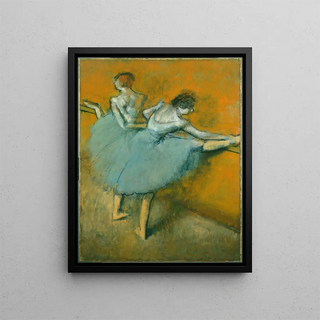Art print | Ballet dancers at the barre - Edgar Degas


View from behind

Frame (optional)
In the fascinating world of art, some works transcend time and space, inviting the viewer to an immersive experience. "Danseurs à la barre - Edgar Degas" is a shining example. This iconic piece captures not only the grace and discipline of dancers but also the very essence of movement and light. By delving into this artwork, one discovers a world where art and dance intersect, revealing the subtleties of a frozen moment that resonates with palpable emotion.
Style and uniqueness of the work
The uniqueness of "Danseurs à la barre" lies in how Degas manages to depict movement with remarkable fluidity. The artist, a master of impressionism, uses delicate brushstrokes to evoke the lightness of bodies in motion. The dancers, captured during their training routine, are depicted with meticulous attention to anatomical details, while maintaining a certain abstraction that leaves room for imagination. The composition is dynamic, with varied poses that testify to the diversity of movements in dance. The color palette, subtly chosen, creates an intimate atmosphere, bathed in a soft light that seems to emanate from the figures themselves. This painting goes beyond a simple representation; it becomes a celebration of the beauty of the body in action, an ode to the effort and passion of artists.
The artist and his influence
Edgar Degas, an emblematic figure of impressionism, knew how to blend academic tradition with the innovations of his time. Born in 1834 in Paris, he was deeply influenced by the artistic environment of his era, while cultivating a personal style that sets him apart from other masters. His fascination with dance, particularly ballet, gave rise to a series of works exploring themes of performance and the daily life of dancers. Degas does not merely depict outer beauty; he delves into the intimacy of his subjects, revealing their struggles and aspirations. His unique approach has inspired many artists, and his legacy endures in the world of contemporary art, where dance continues to be a source of inspiration in

Matte finish

View from behind

Frame (optional)
In the fascinating world of art, some works transcend time and space, inviting the viewer to an immersive experience. "Danseurs à la barre - Edgar Degas" is a shining example. This iconic piece captures not only the grace and discipline of dancers but also the very essence of movement and light. By delving into this artwork, one discovers a world where art and dance intersect, revealing the subtleties of a frozen moment that resonates with palpable emotion.
Style and uniqueness of the work
The uniqueness of "Danseurs à la barre" lies in how Degas manages to depict movement with remarkable fluidity. The artist, a master of impressionism, uses delicate brushstrokes to evoke the lightness of bodies in motion. The dancers, captured during their training routine, are depicted with meticulous attention to anatomical details, while maintaining a certain abstraction that leaves room for imagination. The composition is dynamic, with varied poses that testify to the diversity of movements in dance. The color palette, subtly chosen, creates an intimate atmosphere, bathed in a soft light that seems to emanate from the figures themselves. This painting goes beyond a simple representation; it becomes a celebration of the beauty of the body in action, an ode to the effort and passion of artists.
The artist and his influence
Edgar Degas, an emblematic figure of impressionism, knew how to blend academic tradition with the innovations of his time. Born in 1834 in Paris, he was deeply influenced by the artistic environment of his era, while cultivating a personal style that sets him apart from other masters. His fascination with dance, particularly ballet, gave rise to a series of works exploring themes of performance and the daily life of dancers. Degas does not merely depict outer beauty; he delves into the intimacy of his subjects, revealing their struggles and aspirations. His unique approach has inspired many artists, and his legacy endures in the world of contemporary art, where dance continues to be a source of inspiration in






